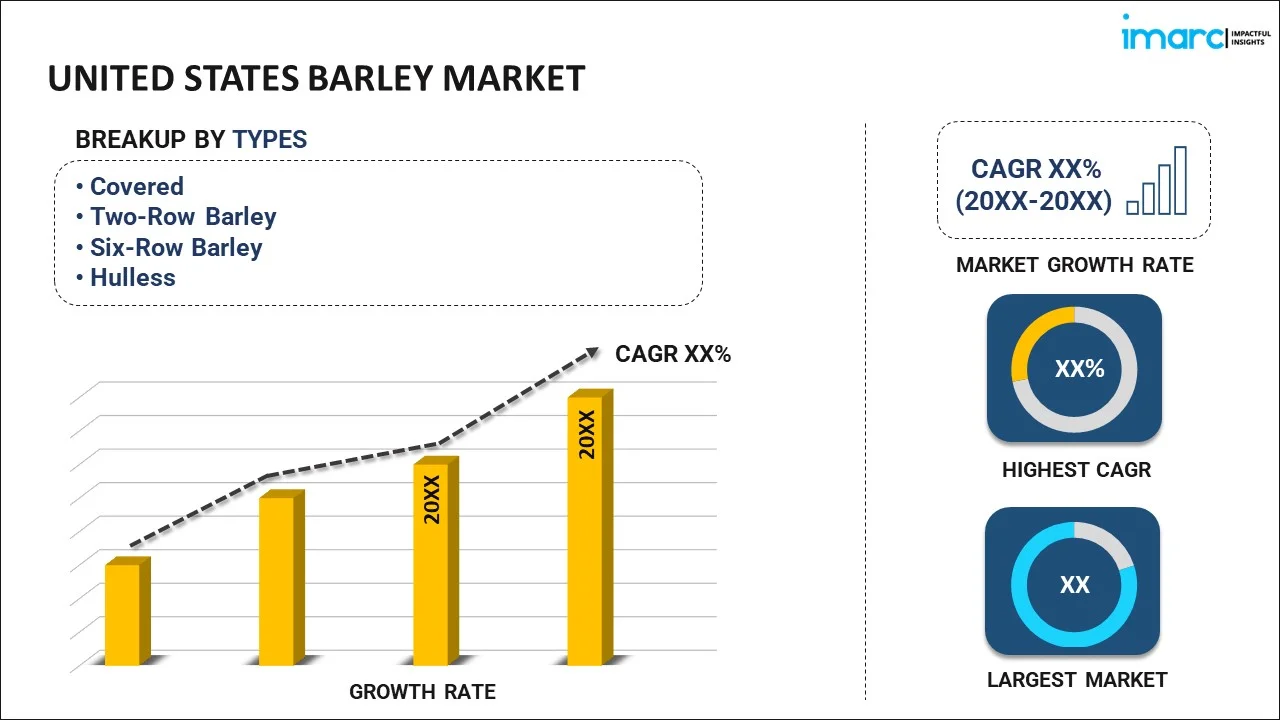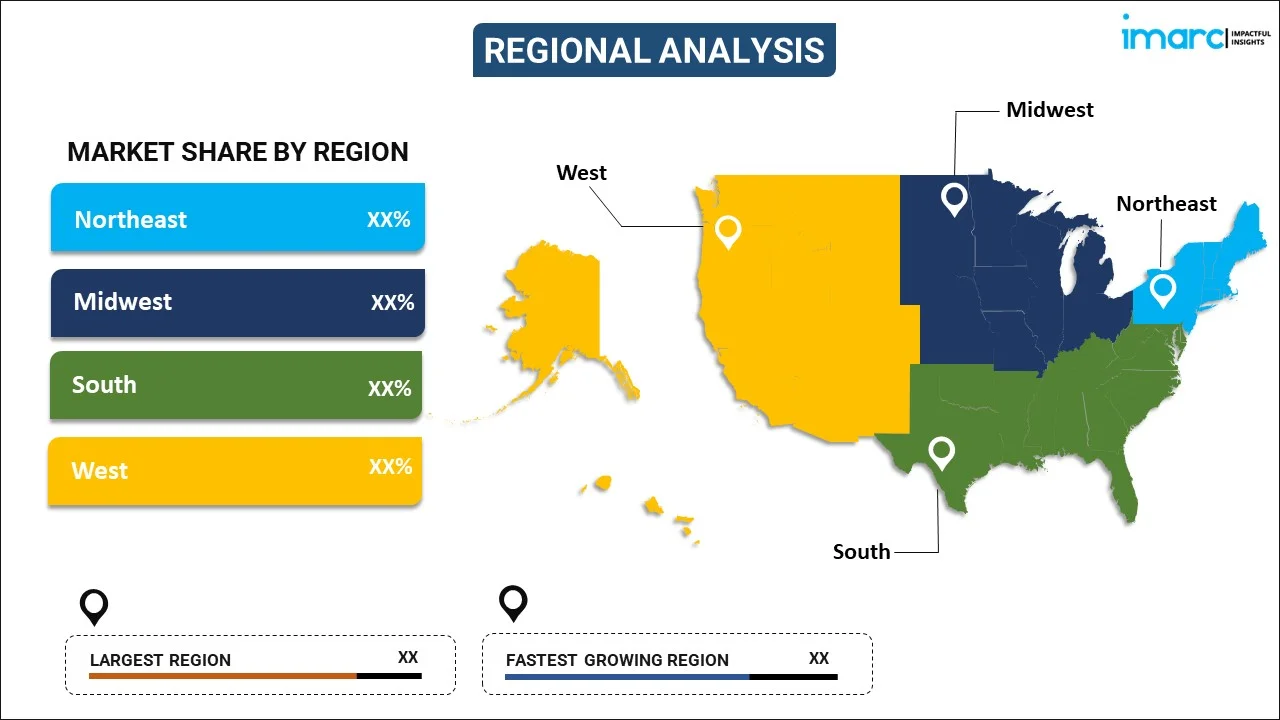
United States Barley Market Report by Type (Covered, Two-Row Barley, Six-Row Barley, Hulless), Grade (Food Grade, Feed Grade, Malt Grade), Distribution Channel (Supermarkets and Hypermarkets, Departmental Stores, Specialty Stores, Online Stores), Industry Vertical (Food and Beverages, Pharmaceuticals, Seed Industry, Personal Care, Animal Feed, Nutraceuticals, and Others), and Region 2025-2033
Market Overview:
The United States barley market size reached USD 6.0 Billion in 2024. Looking forward, IMARC Group expects the market to reach USD 8.4 Billion by 2033, exhibiting a growth rate (CAGR) of 3.9% during 2025-2033. The increasing health consciousness among consumers, the rising demand for barley in beer production, and the extensive usage of barley in the food and beverage (F&B) industry represent some of the key factors driving the market.
|
Report Attribute
|
Key Statistics
|
|---|---|
|
Base Year
|
2024 |
|
Forecast Years
|
2025-2033
|
|
Historical Years
|
2019-2024
|
| Market Size in 2024 | USD 6.0 Billion |
| Market Forecast in 2033 | USD 8.4 Billion |
| Market Growth Rate (2025-2033) | 3.9% |
Barley is a robust cereal grain that is among the oldest and most widely consumed grains worldwide. Originating in Ethiopia and Southeast Asia, it's adaptable to a variety of climates, thereby making it a globally cultivated crop. Barley is characterized by a nutty flavor and chewy texture and serves various culinary purposes. Whole grain barley, rich in nutrients, is used in soups, salads, and side dishes. Pearled barley, with the bran removed, is popular in dishes like risotto. A key use of barley is in the production of beer and whiskey, where it's malted to create fermentable sugars. Despite its gluten content, which renders it unsuitable for those with celiac disease or gluten sensitivity, barley remains a versatile and nutritious grain. Nutritionally, barley is rich in fiber, vitamins, and minerals. It has various health benefits, including improved digestion, weight management, and heart health.
United States Barley Market Trends:
The increasing demand for barley in beer production represents one of the key factors driving the growth of the United States barley market. This, coupled with the booming craft beer industry in the U.S. is contributing significantly to the demand for barley, which is acting as a major growth-inducing factor. The rise of microbreweries and the increasing popularity of home brewing are bolstering the market for high-quality malting barley. The market is also driven by the growing trend toward health-conscious eating in the U.S., along with the increasing consumer inclination toward whole grains and high-fiber foods. Barley, being a rich source of dietary fiber and nutrients, fits well into this trend. The rising popularity of plant-based diets also augments the demand for barley as a nutritious grain option. In line with this, barley is considered a sustainable crop due to its water efficiency and adaptability to diverse climates and soil conditions. As concerns over environmental sustainability grow, crops like barley that include lower environmental impacts are gaining favor. In addition to this, barley is being used innovatively in the food and beverage industry, along with new products like barley-based snacks, cereals, and beverages entering the market. These novel products expand the appeal of barley to a wider range of consumers. The government programs support the cultivation of barley through various farm support, research funding, and crop insurance programs. Such initiatives help stabilize the domestic barley market. Apart from this, the livestock industry in the U.S. is substantial, and barley is commonly used as feed grain. While it faces competition from other feed grains like corn and soybeans, the demand from the livestock sector still contributes to the market. Moreover, the U.S. is one of the world's leading barley exporters. The increasing demand for barley, especially for use in brewing and as animal feed, is creating a positive outlook for the market across the country.
United States Barley Market Segmentation:
IMARC Group provides an analysis of the key trends in each segment of the United States barley market report, along with forecasts at the country level for 2025-2033. Our report has categorized the market based on type, grade, distribution channel, and industry vertical.
Type Insights:

- Covered
- Two-Row Barley
- Six-Row Barley
- Hulless
The report has provided a detailed breakup and analysis of the market based on the type. This includes covered, two-row barley, six-row barley, and hulless.
Grade Insights:
- Food Grade
- Feed Grade
- Malt Grade
A detailed breakup and analysis of the market based on the grade has also been provided in the report. This includes food grade, feed grade, and malt grade.
Distribution Channel Insights:
- Supermarkets and Hypermarkets
- Departmental Stores
- Specialty Stores
- Online Stores
A detailed breakup and analysis of the market based on the distribution channel has also been provided in the report. This includes supermarkets and hypermarkets, departmental stores, specialty stores, and online stores.
Industry Vertical Insights:
- Food and Beverages
- Pharmaceuticals
- Seed Industry
- Personal Care
- Animal Feed
- Nutraceuticals
- Others
A detailed breakup and analysis of the market based on the industry vertical has also been provided in the report. This includes food and beverages, pharmaceuticals, seed industry, personal care, animal feed, nutraceuticals, and others.
Regional Insights:

- Northeast
- Midwest
- South
- West
The report has also provided a comprehensive analysis of all the major regional markets, which include Northwest, Midwest, South, and West.
Competitive Landscape:
The report has also provided a comprehensive analysis of the competitive landscape in the United States barley market. Competitive analysis such as market structure, key player positioning, top winning strategies, competitive dashboard, and company evaluation quadrant has been covered in the report. Also, detailed profiles of all major companies have been provided.
United States Barley Market Report Coverage:
| Report Features | Details |
|---|---|
| Base Year of the Analysis | 2024 |
| Historical Period | 2019-2024 |
| Forecast Period | 2025-2033 |
| Units | Billion USD |
| Scope of the Report | Exploration of Historical and Forecast Trends, Industry Catalysts and Challenges, Segment-Wise Historical and Predictive Market Assessment:
|
| Types Covered | Covered, Two-Row Barley, Six-Row Barley, Hulless |
| Grades Covered | Food Grade, Feed Grade, Malt Grade |
| Distribution Channels Covered | Supermarkets and Hypermarkets, Departmental Stores, Specialty Stores, Online Stores |
| Industry Verticals Covered | Food and Beverages, Pharmaceuticals, Seed Industry, Personal Care, Animal Feed, Nutraceuticals, Others |
| Regions Covered | Northeast, Midwest, South, West |
| Customization Scope | 10% Free Customization |
| Post-Sale Analyst Support | 10-12 Weeks |
| Delivery Format | PDF and Excel through Email (We can also provide the editable version of the report in PPT/Word format on special request) |
Key Questions Answered in This Report:
- How has the United States barley market performed so far and how will it perform in the coming years?
- What has been the impact of COVID-19 on the United States barley market?
- What is the breakup of the United States barley market on the basis of type?
- What is the breakup of the United States barley market on the basis of grade?
- What is the breakup of the United States barley market on the basis of distribution channel?
- What is the breakup of the United States barley market on the basis of industry vertical?
- What are the various stages in the value chain of the United States barley market?
- What are the key driving factors and challenges in the United States barley market?
- What is the structure of the United States barley market and who are the key players?
- What is the degree of competition in the United States barley market?
Key Benefits for Stakeholders:
- IMARC’s report offers a comprehensive quantitative analysis of various market segments, historical and current market trends, market forecasts, and dynamics of the United States barley market from 2019-2033.
- The research study provides the latest information on the market drivers, challenges, and opportunities in the United States barley market.
- Porter's five forces analysis assist stakeholders in assessing the impact of new entrants, competitive rivalry, supplier power, buyer power, and the threat of substitution. It helps stakeholders to analyze the level of competition within the United States barley industry and its attractiveness.
- Competitive landscape allows stakeholders to understand their competitive environment and provides an insight into the current positions of key players in the market.
Need more help?
- Speak to our experienced analysts for insights on the current market scenarios.
- Include additional segments and countries to customize the report as per your requirement.
- Gain an unparalleled competitive advantage in your domain by understanding how to utilize the report and positively impacting your operations and revenue.
- For further assistance, please connect with our analysts.
 Inquire Before Buying
Inquire Before Buying
 Speak to an Analyst
Speak to an Analyst
 Request Brochure
Request Brochure
 Request Customization
Request Customization




.webp)




.webp)












